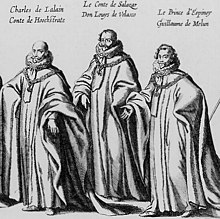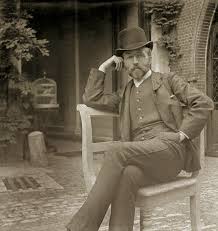
Hoogstraten is a municipality located in the Belgian province of Antwerp. The municipality comprises Hoogstraten, Meer, Meerle, Meersel-Dreef, Minderhout and Wortel.

The House of Rohan is a Breton family of viscounts, later dukes and princes in the French nobility, coming from the locality of Rohan in Brittany. Their line descends from the viscounts of Porhoët and is said to trace back to the legendary Conan Meriadoc. Through the Porhoët, the Rohan are related to the Dukes of Brittany, with whom the family intermingled again after its inception. During the Middle Ages, it was one of the most powerful families in the Duchy of Brittany. They developed ties with the French and English royal houses as well, and played an important role in French and European history.

The Marquess of Lede was a Flemish title in use during the Ancien Régime. Lede is a city in Flanders, Belgium.

The Terlinden family is a Belgian noble family of German origin, with a noble offspring in Belgium. Its titles are Viscount and Baron.
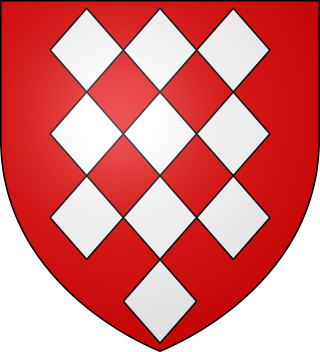
Antoine I de Lalaing (1480–1540), 1st count of Hoogstraten and of Culemborg, was a Hainautese nobleman who held various offices in the court of the Dukes of Burgundy.

Charles de Lalaing, baron and later 1st count of Lalaing, lord of Escornaix.
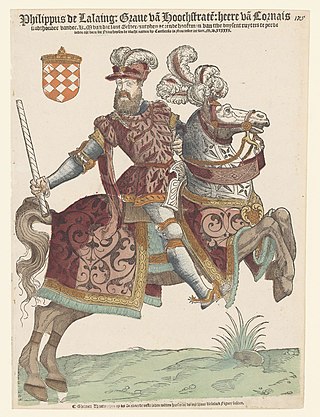
Philip de Lalaing, 2nd count of Hoogstraten was stadtholder of Jülich (1543) and Guelders.

The House of Bethune is a French noble house from the province of Artois in the north of France whose proven filiation dates back to Guillaume de Béthune who made his will in 1213. This family became extinct in 1807 with Maximilien-Alexandre de Béthune, Duke of Sully (1784-1807).

Lamoral, 1st Prince of Ligne was a diplomat in the 17th century.

Vilain and Vilain XIIII is a Belgian noble family. Their coat of arms is basically "Sable, on a chief argent a label of the field", a colour scheme that is present from the earliest Vilains in the 15th century, and is also seen in the Vilain XIIII arms, which have the "XIIII" added to it.

The House of Lannoy is the name of an old and important Belgian noble family that takes its name from the town of Lannoy in northern France. The name comes from l'Annoy, which means 'the alderwood' in Picard French of Flanders.
The Counts of Dammartin were the rulers of the county of Dammartin, based in the current commune of Dammartin-en-Goële as early as the 10th century. Located at the central plain of France, the county controlled the roads of Paris to Soissons and Laon. It seems that this county was initially held by Constance, the wife of Manasses Calvus, the first Count. The name Dammartin-en-Goële comes from Domnus Martinus, the Latin name of St. Martin of Tours, who evangelized the region of Goële in the fourth century. A small town in the district of Meaux in the Department of Seine-et-Marne, ancient village of Region of Île-de-France, it appears to go back to the earliest times; Dammartin-en-Goële, also called Velly, was in 1031 one of the most significant places in France.

The Van der Noot family is a Belgian noble family. The title of Count van der Noot is a title created by Emperor Charles VI on 16 May 1716. Since then this title belongs to the Belgian nobility.
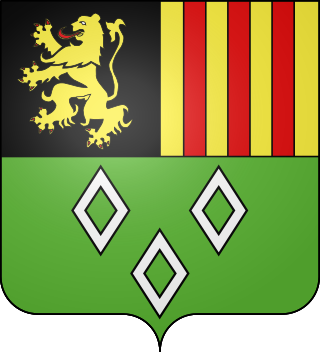
The House of Glymes was an old Belgian noble family, an illegitimate branch of the House of Reginarid, which ruled the Duchy of Brabant. Glymes or Glimes is a municipality of Incourt. Their descendants of the branch of Grimberghen are styled as the Prince de Grimberghen.

Brimeu is a noble family, some members belonging to the Flemish aristocracy. Brimeux, previously in Flanders, is now in France.

The House of Hénin is a family of the Belgian high nobility, one of its branches was titled Prince of Chimay. Alliances were made with important Spanish noble families such as house of Borja and the house of Velasco.
Philip de Lalaing (1499–1550), also known as "the bastard of Lalaing", was an illegitimate son of Antoine I de Lalaing and Ysabeau d'Haubourdin. He was legitimised in March 1524, and served Margaret of Austria as master of the household, knight of honour, and adviser. In 1529 Margaret sent him to France as an ambassador extraordinary on behalf of Charles V, Holy Roman Emperor.

Charles de Lalaing, 6th Count of Hoogstraeten was a Flemish noble Lord from the House of Lalaing.

